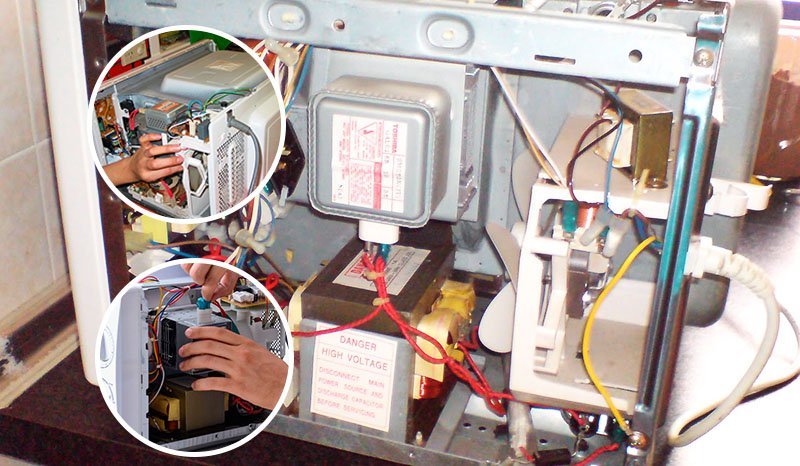Signs of malfunction: the light is on, the turntable is spinning, the grill is working but the microwave does not heat the food.
The problem is often caused by the failure of a magnetron. Otherwise, the causes may have to do with:
- capacitor
- tranfrormer
- high-voltage diode
- high voltage fuse
How to identify the malfunction
- Check the voltage supply of a high-voltage transformer’s primary winding when starting the microwave oven (be sure to take safety precautions from electric shock).
- If the voltage is okay, then you need to check the contacts and high-voltage parts: high-voltage transformer, high-voltage capacitor, high-voltage diode, and magnetron.
- If the listed parts in the high-voltage circuit work fine, then you will need to replace magnetron with a new one. Maybe high-voltage diode needs to be replaced as well.

The microwave does not heat well, does not heat at all, or heats “from time to time”
- If the voltage in the power grid is less than 210 volts, then the microwave power is reduced. This is especially true for countryside and rural areas. Due to a lower voltage, the microwave takes several times more time to heat up, which is why it heats “from time to time”.
- The fault may have to do with the control circuit (timer or a control unit).
- The fault may be related to power circuits (high-voltage transformer, high-voltage fuse, high-voltage diode, capacitor, or magnetron).
- When it comes to inverter microwave ovens, the malfunction may occur due to the failure of the inverter.
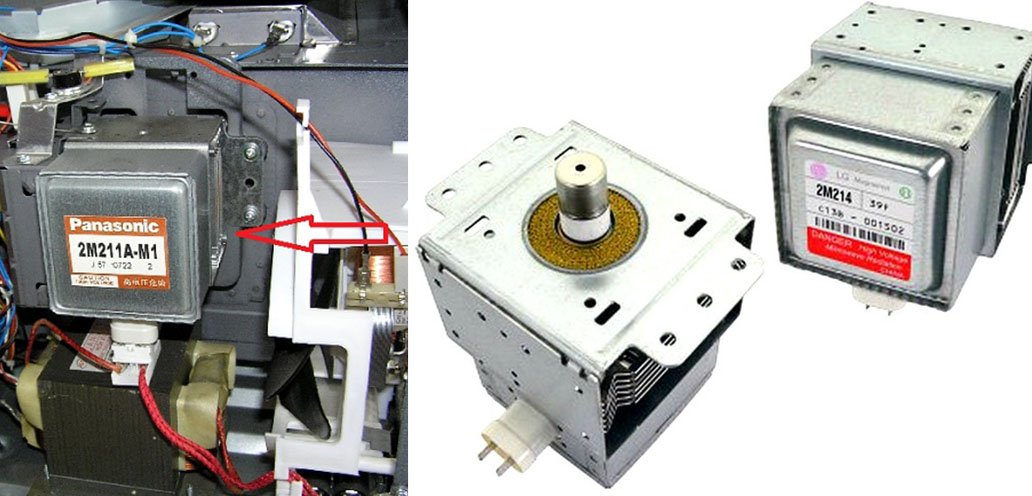
Detecting the Malfunction and Troubleshooting
- Check the power supply voltage. When the voltage drops below 215 Volts – the microwave does not heat the food well enough. Once the voltage is normal, the microwave oven will start to work fine.
- If the voltage is normal, then it’s time to replace the magnetron with a new one.
How to prevent the failure of magnetron? The breakages most often occur if:
- The cooking cavity was empty during operation – it led to sparking which, in turn, caused damage to magnetron.
- There was some metal item in the cavity during operation
- Natural wear of the magnetron, loss of emission.

The microwave does not heat and makes buzzing noise
Let us consider the situation when the microwave does not heat and produces buzzing noise.
1) High Voltage Transformer
If a high-voltage transformer is broken, the operation of a microwave is accompanied by a loud noise and vibration and you can feel the smell of burning and smoke. Having this breakdown, the microwave also stops heating products.
2) Magnetron
A defective magnetron is the third possible cause of your microwave oven malfunction, you can also hear a buzzing noise. Check the serviceability of the magnetron. Replace it if necessary.
3) High Voltage Capacitor
Capacitor is an electrical device that stores electrical energy in an electric field. The malfunction of a high-voltage condenser in a microwave oven can cause a lack of generation of microwaves, it may also cause a humming noise.
4) High Voltage Diode
A diode is an electronic component that conducts current primarily in one direction and blocks its flow in the opposite direction. If the diode of your microwave oven is out of order, the oven stops heating and you will hear a buzz.
How to detect the malfunction
- At first, you need to check a high-voltage fuse, check the parts diagram.
- If the fuse has burnt, we need to check multiplier components (here, the doubler components) – a diode and a capacitor.
- The capacitor needs to be tested with an ohm meter (tester) for charging – discharging. If the tester has two batteries, then there is no problem – the needle will move significantly. If there is only one battery, then the arrow moves slightly, but it will still be clear. If the capacitor is in good condition, the needle will deflect full-scale. If the ohm meter needle stops at a certain value, then the high-voltage capacitor is broken, this is not a rare thing. If the needle does not move, then the capacitor is out of order.
- It is difficult to check a diode, so just replace it with a new one.
- If the diode and the capacitor work fine, we need to check the magnetron – its feed-through capacitor and its terminals should not give a signal with the magnetron case, if they do, then the feed-through capacitor is damaged (very often, you can see a side crack and a residue).
GE microwave not heating

Possible causes of why a microwave stopped heating
- insufficient voltage;
- the microwave door switch does not work;
- the electric fuse has burnt;
- high voltage fuse in the box is damaged;
- the fuse on the transformer is faulty;
- the doubler is damaged – diode;
- the doubler breakage – capacitor;
- the transformer does not send voltage to control panel;
- the malfunction of a feed-through capacitor;
- electromagnetic lamp does not heat – magnetron.
Kenmore microwave not heating
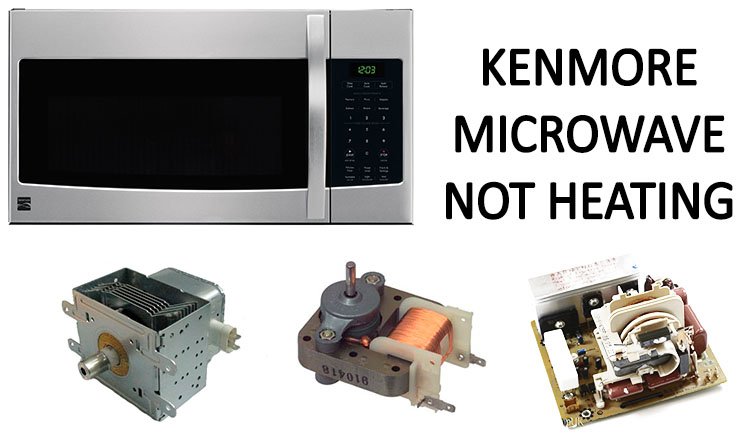
Possible causes of why a microwave stopped heating
- Low mains supply voltage – less than 220 V. Even a small deviation (20 V) can affect the performance of a microwave oven, including its heating capacity. As a result, the turntable may be hot, but the food on top of it will remain cold. To resolve this issue, we recommend installing an uninterrupted power supply unit.
- Electric overload caused by the fact two or more powerful appliances get power from a single outlet. In this case, it is necessary to use a separate outlet for each appliance.
- The door latches are broken. The door cannot be closed tightly, so the microwave heats the food inefficiently. To solve the problem, you will need to repair or replace the door latches.
- The fuse. When you remove the cover, you should first check the operability of the fuses. If they are blackened or the wire inside is burnt out, then you just need to replace the fuse with a new one.
- If you hear a buzz or a loud noise from the inside the microwave when you switch it on, it may indicate that the capacitor is broken.
- If you have checked all the elements of the circuit and haven’t revealed any problems, then, most likely, the cause of why a microwave does not heat up is in the damaged magnetron.
Whirlpool microwave not heating

If one of these components breaks down, your microwave will stop heating your dinner:
- micro switch;
- high voltage capacitor
- high voltage transformer
- diode
Micro switch prevents microwave from switching on when the door is open. The first sign that it is broken is when the microwave oven turns on, the fan starts working, the turntable begins to spin, the light is on, but the food remains cold.
If a high-voltage transformer is broken, the microwave oven will begin to vibrate and make a buzzing noise, you will feel the smell of burning. You can check its performance using a special tester – ohm meter. The normal primary winding value is 2-3 ohms, for the secondary one it will be 150 ohms.
If a high-voltage capacitor breaks, the microwave will start to buzz and hum. Before testing, the capacitor needs to be discharged. Its normal resistance value is 10 ohms.
A high voltage diode transmits current in one direction and blocks its flow in the opposite direction. Therefore, if it breaks, the microwave will stop heating and will start to produce a buzzing sound. By the way, you don’t need to check the diode as it is better to replace it immediately with a serviceable part.
If the magnetron is faulty, you will also hear a hum and a buzz. The magnetron may break if the microwave heats without having anything inside and if you warm up food or liquid in a metal dish. You can understand whether it is ‘alive’ or ‘dead’ by measuring the resistance between the contacts. The normal value is 1 ohm. Measuring the resistance in the heater-housing circuit at the maximum limit of the tester will help to ensure that there is no power leakage to the housing.
LG microwave not heating
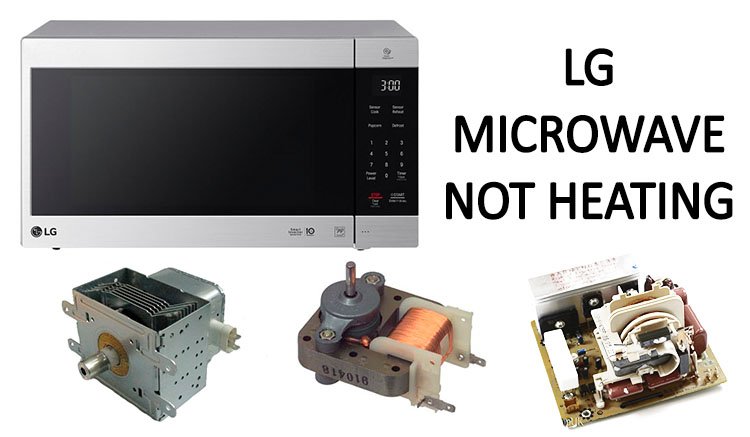
Your microwave will not heat the food:
- If there are significant voltage drops in the power grid. Even at 200 V, the food will not fully heat up and will remain cold in the center. To prevent such issues, you can use a voltage regulator or uninterruptible power supply unit.
- If the latch on the door is broken and it is not tightly closed. You can try to repair it or completely replace it with a new part.
- When you connect more than two energy-hungry devices to one outlet. You can make a separate connection.
- If the wrong mode was selected. For example, you might forget to switch the mode back after using the defrost mode.
- Because of the control unit breakdown or the breakage of timer.
- The cause might hide in the power circuit – in the high-voltage diode, capacitor, fuses, high-voltage transformer or magnetron.
Samsung microwave not heating
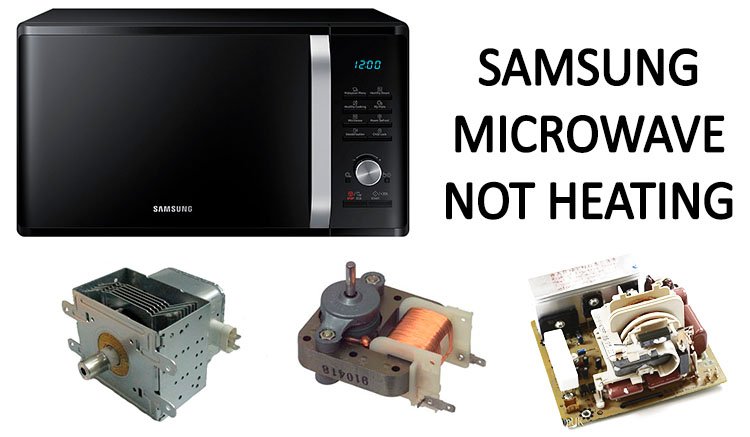
The microwave doesn’t work, what might be the causes:
- low voltage in the power grid, which is not enough for the device;
- the microwave door switch has failed;
- the fuse has burnt (in the housing, on the transformer or the power fuse);
- defective doubler: diode or capacitor;
- feed-through capacitor is broken;
- electromagnetic lamp is out of service;
- the transformer does not send voltage to the control panel.
Each of these issues is solved in its own way. In some situations, you can fix the malfunction by yourself, and sometimes it is better to contact a service center. For example, when it comes to more expensive Samsung or LG microwave ovens, it is better to contact the repairmen right away. Moreover, if the appliance is under warranty, most of the listed errors will be eliminated for free of or at a reduced cost. Therefore, it is best to send the microwaves of such well-known brands as Samsung to the professional service centers. This will be the key to a good operability in the future.
Frigidaire microwave not heating
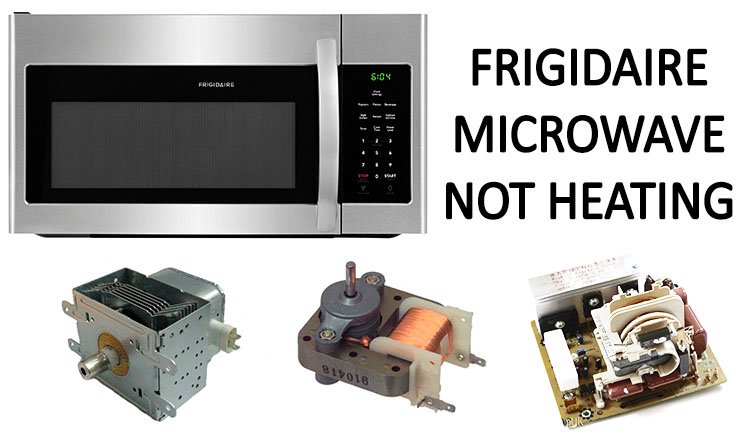
Causes of malfunctions
- Sometimes it happens that a user does not switch the microwave back from defrosting to cooking mode. As a result, the appliance does not heat the food as it should.
- Microwave requires 220 volts for normal operation. Even a10-20 volt drop will make the appliance lose its heating power. Use an uninterruptible power supply unit or a voltage regulator.
- Sometimes the owners plug several appliances like electric kettle and extension cords in a single outlet. The outlet cannot handle that amount of electricity, the appliance does not heat up well or simply turns off. Use a separate power source for each device.
- If the microwave does not heat well or heats from time to time, the cause may have to do with the door. It is necessary to adjust its latch.
If all of these tips did not help, you will need to look into the problem a bit deeper and try to find the cause of the breakdown. If the microwave oven hums, buzzes, stops heating, but at the same time works, then the cause might be:
- A door switch
- One of the fuses.
- Diode or capacitor.
- Magnetron.
The problem may also be related to the inverter if you use certain type of microwave.
Maytag microwave not heating

Microwave may not heat because of a serious damage or some easily fixable cause:
- Microwave may not work well due to low voltage. 220 V is a necessary value for normal operation of the magnetron. If the voltage is lower, it will work, but the temperature will rise very slowly. The situation may be improved by installing a stabilizer. Of course, it is better to install it at the entrance of your house or apartment, but you can use a small stabilizer only for this equipment.
- If the input voltage is 220 V, but the microwave uses the same source of energy as other power-consuming appliances, it may lead to a voltage, which will make the microwave work at reduced power. The solution is quite simple – you need to switch some of the devices to other groups (to outlets powered by another power line).
- There is no contact in the outlet or the cord is damaged. It is very easy to check the outlet – just plug the device in another one. The power cord needs to be inspected visually. If there is no visible damage, you will need to use a multimeter. If you don’t want to use a multimeter, you can bend the cord in different places while the microwave is working. If it does not affect the work, then the cord is not to blame.
More serious issues
Fuse
Sometimes the microwave does not produce heat due to a faulty fuse in the power supply circuit of the magnetron. Not all models have it, but it may cause the magnetron malfunction. Such fuse sometimes may be found easily, but most often it is hidden under the cover (see the photo), as it put in the high-voltage circuit.
Issues with a magnetron
Several damages may be caused by a magnetron. Let’s start again with the simplest thing – poor contacts. The wires from the filament winding of the transformer come to the magnetron terminals. They are not easily removed. The contact may have been deteriorated due to the heat. You can improve it by additionally clamping the contacts with pliers.
Mica sheet issues
The inside of the port in the cooking chamber has a mica plate. Sometimes the microwave does not heat up because it has too much deposit and the waves simply cannot overcome this obstacle. Such damage may even cause sparks and something like lightning or even fire during operation.
The condenser has burnt or the diode is faulty.
If the microwave stops heating – you can switch it on, it buzzes, spins the turntable, but the food remains cold, it may indicate issues with the condenser. Take the tester and check it. Put it to the resistance measurement mode.
Amana microwave not heating
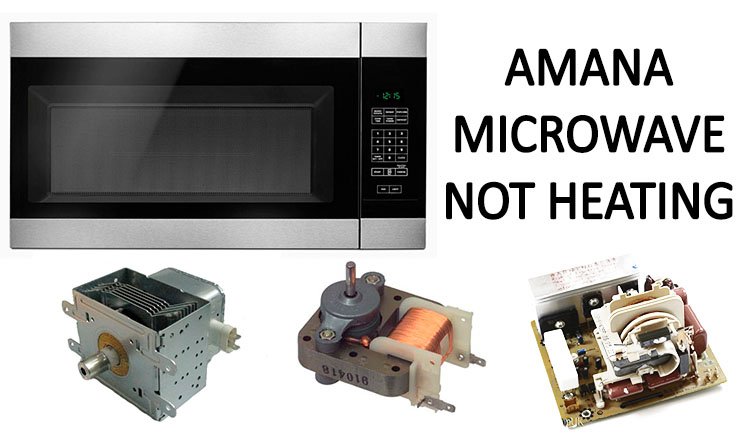
Before you start repairing the microwave by yourself or with the help of specialists, you need to determine what kind of malfunction it is:
- The voltage is less than 220 volts.
- In inverter microwave ovens – the breakdown of the inverter.
- Malfunction in the control circuit: timer or control unit.
- Malfunction in the power circuit consisting of a fuse, high-voltage diode, capacitor, magnetron and high-voltage transformer.
If the voltage is okay, then the microwave has really broken and the cause needs to be found inside – in the power circuit:
- Fuse – find the fuse looking at the device part list which comes with the microwave. If they are blackened or the fusing element is torn, we simply replace it with a new one.
- Condenser – if it breaks, you can hear a hum or a buzz when the appliance works. The capacitor needs to be checked with an ohm meter (if the needle moves – it works, if not – it is broken). If a malfunction is detected, it should be replaced with a new part, but make sure you discharge it before you start the replacement.
- High-voltage diode or doubler – the blown fuse and a strong hum may indicate a problem. It is very difficult to check it, so it is better to replace it immediately with a new one.
Magnetron – when it breaks the microwave also produces a hum and a buzz, and when you open the cover you can see cracks and carbon on the sides of it. If you cannot check it visually, then try using an ohm meter – check the feed-through capacitor (it should not give a signal with the case of the magnetron itself) and the filament. After detecting the source of the problem, we can either fix it or replace the entire magnetron with similar one.
